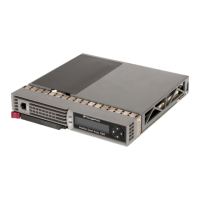Configuration Procedures - for OpenVMS Environments
80 MSA1000 Installation Guide
Identifying the Server and Operating System to the MSA1000
Because the MSA1000 can operate in a variety of operating system environments,
you must identify your server to the MSA1000. These identification steps include
changing the name of the connection to the server to a meaningful name and
identifying your server’s operating system.
Identify the connection to the server and its operating system using the same
utility you will later use to configure the storage.
For information on identifying your server, see the “Managing Connection
Profiles” section of the HP StorageWorks MSA1000 Command Line Interface
Reference Guide. This guide is available on the MSA1000 Support
Documentation CD and the MSA1000 website at
http://www.hp.com/go/msa1000
.
Configuring the Storage Arrays and Logical Volumes
Planning the storage configuration is critical to the successful and efficient
deployment of any storage array system. As discussed in Chapter 1: “Installation
Procedures - for all MSA1000 Deployments”, plans should include decisions
about total system capacity, fault-tolerance, performance, and availability.
Note: Refer to the “Plan How you Want to Configure your Storage” on page 18 and
“Review MSA1000 Installation Best Practices” on page 21 for help developing a
configuration plan.
After your storage plan is developed, configure the storage by using the CLI.
For information on using the CLI, see the HP StorageWorks Modular Smart Array
1000 Command Line Interface Reference Guide. This guide is available on the
MSA1000 Support Documentation CD and the MSA1000 website at
http://www.hp.com/go/msa1000
.
Assigning ID Numbers to the Controllers and LUNS
When configuring your MSA1000, you must assign a unique ID number to each
MSA1000 controller AND to each MSA1000 storage LUN.
See the HP StorageWorks Modular Smart Array 1000 Command Line Interface
Reference Guide for specific instructions.

